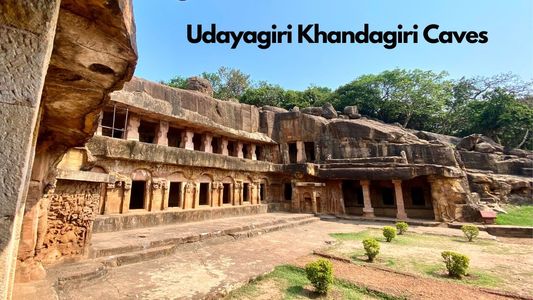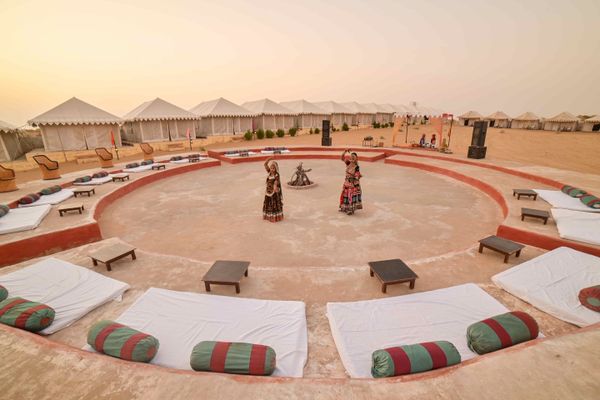Explore Udayagiri and Khandagiri Caves - Ancient Marvel of the Past
 Vikram Singh
14 Nov, 2024
10 mins read
1437
Vikram Singh
14 Nov, 2024
10 mins read
1437

The Udayagiri and Khandagiri Caves at Bhubaneswar, Odisha, are popular historical places. The significance of these ancient cave formations lies in culture and architecture. They have existed since the 2nd century BC and are proof of India's rich rock-cut architecture, antique art, and the Jain faith. Situated on twin hills—Udayagiri (which means "Sunrise Hill") and Khandagiri (which means "Broken Hill")—the caves initially served as shelters for the Jain monks. They represent an era marked by a deep sense of spirituality along with great support from the royal class. We're going to discuss the historical facts, architectural features, and specific attractions at Udayagiri and Khandagiri Caves that continue to captivate many visitors as well as researchers.
Background History of Udayagiri and Khandagiri Caves
The Udayagiri and Khandagiri Caves belonged to the 1st century BCE. They are from the time of King Kharavela, who ruled the region of Kalinga, the modern state of Odisha. King Kharavela was a devout Jain, for which he tried through architectural masterpieces and inscriptions to spread Jainism. These caves were abodes for Jain monks; these caves served not only as sheltered retreats but also as places for meditation, study, and other spiritual pursuits.
These caves have been excavated on the orders of King Kharavela. The major site for the more elaborate caves was Udayagiri. As against it, the caves in Khandagiri are smaller and meagre in design. Collectively, these twin sites narrate a tale of royal patronage, religious devotion, and the architectural acumen of the times.
Architectures and designs
The Udayagiri and Khandagiri Caves are excellent examples of rock-cut architecture and are regarded as one of the earliest cave complexes in India. The caves are cut from the sandstone hills with the fine craftsmanship of carvings in rock-cut designs. In all, there are 33 caves on Udayagiri Hill 18 and Khandagiri Hill 15.
Udayagiri: This is one of the more elaborate cave sites, with carvings, inscriptions, and sculptures. Amongst the most stunning caves here is the Rani Gumpha, a colossal cave, with relief sculptures painted with scenes that tell stories of their royal lives and motifs of animals, dancers, and musicians. The other notable cave is the Hathi Gumpha (Elephant Cave), which contains an inscription that records the achievements of King Kharavela and provides information on the history and culture of ancient Kalinga.
The caves of Khandagiri Hill are slightly less complex but have great workmanship. Ananta Gumpha is a site that has some beautiful decorations and carvings, and there is Tatowa Gumpha, which is famous for its intricate bird carvings. Though the caves in Khandagiri are less ornate than those of Udayagiri, they are as significant for their historical and religious importance.
The caves are different in a two-storey structure with lower and upper levels, and access to all levels is through a series of carved stairways. The cave design is simple as well as complex where both reflect the purpose of the spiritual meaning of the caves and the artistic capabilities at that time.
Religious Significance of Udayagiri and Khandagiri Caves
The Udayagiri and Khandagiri Caves have significant religious importance for the Jain sect because it was a place where Jain saints used to meditate and reside. The inscriptions and carvings inside the caves often contain images of Jain idols, and most of the caves contain reliefs consisting of Jain symbols like lotus flowers and the dharma chakra (wheel of Dharma).
The caves were one of the centres where Jainism's teachings were spread during the reign of King Kharavela, who patronized Jainism's development in the region. One of the Jain festivals that attract people to visit the site is Mahavir Jayanti. Today the caves have become a center of pilgrimage and worship for the Jainas.
Major Attractions at Udayagiri and Khandagiri Caves
The Udayagiri and Khandagiri Caves have numerous highlights that portray the grandeur of ancient Indian art and Jain history. Some of the major attractions include:
Rani Gumpha: This cave in Udayagiri is known as the Queen's Cave, which can be described as a two-storeyed decorated niche with various carvings accounting for the scenes of royal life, animals, dancers, and floral motifs in intricate details. The cave counts as one of the most visited due to its artistic beauty and historical importance.
Hathi Gumpha Inscription: A long inscription in Brahmi script, from the Elephant Cave, narrates the achievements and conquests of King Kharavela, one of the most important sources of historical information on the Kalinga kingdom, very valuable to historians and archaeologists.
Ananta Gumpha: Situated at Khandagiri Hill, Ananta Gumpha has carvings of some Jain religious symbols and is marked with a quiet surrounding. It is a small but sacred cave indicating the simple life of Jain and constant meditation.
Known for an image of Lord Ganesha carved inside its walls, this cave on Udayagiri has been named after a god, which has a lot to do with the word "inclusion" and shared culture because Ganesha is typically associated with Hinduism.
Tatowa Gumpha: Located on Khandagiri Hill, the Gumpha gets its name from beautiful carvings of parrots, Tatowa in Odia. It speaks for the then prevalent artistic taste and reveals the realistic ableness of detail in Jain rock-cut art.
So, on both the hills of Jain Icons and Symbols, the motifs of lotus are very widespread. The dharma chakra and figures of Jain monks in meditation also let people know about the spiritual essence of the caves, which attracts followers of Jainism as well as those interested in ancient spirituality.
Visit the caves of Udayagiri and Khandagiri.
A visit to the Udayagiri and Khandagiri Caves will be a lifetime experience, as it allows you to travel through history and see and enjoy the creativity, faith, and rich cultural heritage behind the ancient structures. A few more tips for planning your visit:
Location: The caves are situated some 6 kilometres from Bhubaneswar, the capital of Odisha, which is easily accessible by road.
Entry Fee: There is an entry fee paid by Indians and foreign tourists. Extraneous charges are levied separately in case one plans to make use of a camera or video recording equipment.
Best Time to Visit: The best time to visit is during the winter months between October to February. Compared to summers in Odisha when the temperatures can be extreme, winters prove to be a better time to visit as the weather is mildly warm and pleasant.
Guided Tours: To appreciate the full history and cultural importance of the caves, one would consider hiring a guide that elaborates on the carvings, inscriptions, and historical context of each of these caves.
Conservation and Preservation Efforts
Given the historical and cultural significance attached, the caves of Udayagiri and Khandagiri have been declared protected monuments by the Archaeological Survey of India. Works are now being taken to conserve the structural stability of the caves, protect the inscriptions, and regulate the number of visitors in order not to damage the carvings on the ancient walls.
Preserving these caves is of great importance because they symbolize a unique chapter in Indian history, religious devotion, and architectural skills. Efforts must continue so that future generations may see and learn from this fantastic heritage.
Written By:
Vikram Singh



Hotels at your convenience
Now choose your stay according to your preference. From finding a place for your dream destination or a mere weekend getaway to business accommodations or brief stay, we have got you covered. Explore hotels as per your mood.





